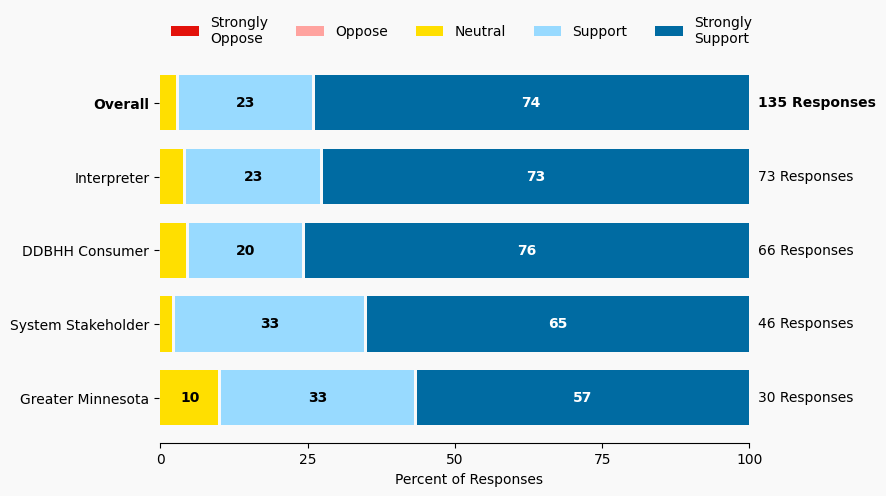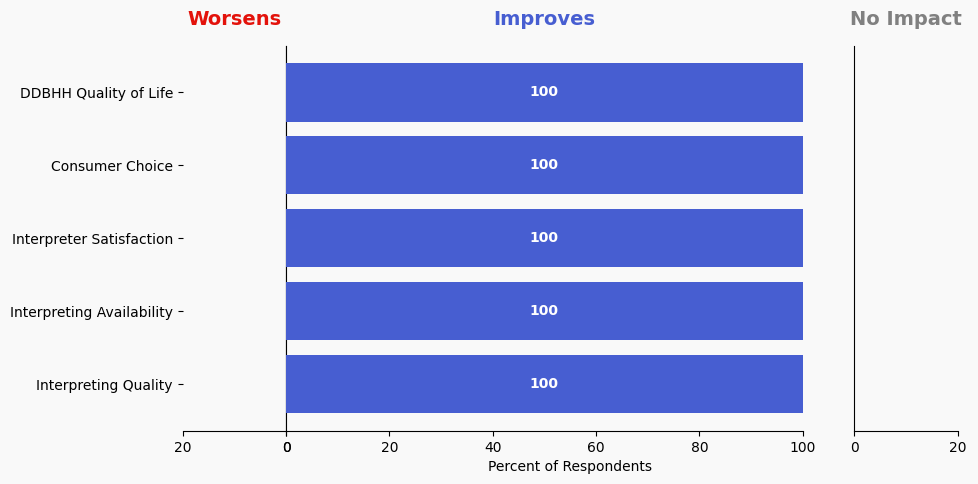55 Educate Health Care Systems on the Need for On-Site Interpreters
Issue: Decision makers in health care settings make decisions that negatively impact the deaf, deafblind and hard of hearing community and interpreters.
Proposed Solution: As many hospital systems are shifting to VRI services only, there is a need for education to maintain policies and contracts to allow for on-site interpreters in healthcare settings. A coalition, with the Minnesota Department of Health, the Minnesota Hospital Consortium and State Services as the co-leads for this project, could provide education and outreach to all medical providers regarding the ADA and Joint Commission Standards. Using NAD resources as a basis, provide clear and direct information to administrators regarding medical providers’ responsibilities to provide on-site interpreters when requested by DDBHH patients.
Expected outcome: DDBHH patients will gain better health outcomes due to better communication access.
Who is impacted: Consumers, interpreters, health care systems
Timeline: 6 months
Note: The Minnesota Hospital Consortium is a valuable partner for this endeavor.

Summary of Support Image Description
The stacked bar charts show how respondents rated their level of support and the total number of responses. The percentage for the five support levels is shown from left to right: Strongly Oppose (Dark Red), Oppose (Light Red), Neutral (Yellow), Support (Light Blue), and Strongly Support (Dark Blue).
Respondents may identify with multiple subgroups. The overall level of support is:
Overall
Strongly Oppose: 0%
Oppose: 0%
Neutral: 3%
Support: 23%
Strongly Support: 74%
Click to see the detailed image description for each subgroup.
Interpreter
Strongly Oppose: 0%
Oppose: 0%
Neutral: 4%
Support: 23%
Strongly Support: 73%
Greater Minnesota
Strongly Oppose: 0%
Oppose: 0%
Neutral: 10%
Support: 33%
Strongly Support: 56%
DDBHH Consumer
Strongly Oppose: 0%
Oppose: 0%
Neutral: 5%
Support: 20%
Strongly Support: 76%
System Stakeholder
Strongly Oppose: 0%
Oppose: 0%
Neutral: 2%
Support: 33%
Strongly Support: 65%
Overview of Respondents Opting for In-Depth Solution Analysis
After indicating their support level, 4% of the 135 respondents opted in to further assess whether the solution would worsen or improve on five metrics. Of the opt-in reviewers (6 respondents), 100% supported the solution, 0% were neutral on the solution, and 0% opposed the solution.
The remaining 129 respondents did not opt in to further assess the solution. Of these people, 96% support the solution, 3% were neutral on the solution, and 0% opposed the solution.
Reviewer Evaluation of Solution Effectiveness

Solution Effectiveness Image Description
The stacked bar charts show how respondents assessed the effectiveness of this solution based on five metrics. For each metric, the percentage of respondents is shown from left to right: Worsens (Red), Improves (Blue), No Impact (Gray).
DDBHH Quality of Life
Makes It Worse 0%
Makes It Better 100%
No Impact 0%
Interpreter Satisfaction
Makes It Worse 0%
Makes It Better 100%
No Impact 0%
Consumer Choice
Makes It Worse 0%
Makes It Better 100%
No Impact 0%
Interpreting Availability
Makes It Worse 0%
Makes It Better 100%
No Impact 0%
Interpreting Quality
Makes It Worse 0%
Makes It Better 100%
No Impact 0%
Reviewer Feedback and Insights
Interpreter
Comments from Interpreters highlight the importance of securing testimonies from the community Comments from Interpreters emphasize the importance of securing testimonies from community members about adverse events to demonstrate the negative impact of relying on VRI services in health care settings. . Concerns are raised about the overuse of VRI in metro areas where on-site interpreters are available, with interpreters pointing out the increased risks of miscommunication and technical failures when using VRI, especially in medical settings.
Deaf, DeafBlind, Hard of Hearing
Comments from DDBHH Consumers emphasize the need for health care providers to ask consumers about their preferences for VRI (Video Remote Interpreting) or on-site interpreters, instead of making the decision on their own. There is a recommendation to involve all major accrediting bodies in the education initiative, not just the Joint Commission.Comments from DDBHH Consumers emphasize the importance of educating health care systems to ask patients about their preferences for when to use VRI versus on-site interpreters. One comment suggests involving all major accrediting bodies in the education initiative to ensure comprehensive understanding and implementation.
System Stakeholder
Comments from System stakeholders raise concerns about the limitations of VRI, especially in the metro area where on-site interpreters are available. One comment suggests ensuring that local VRI services have enough staff to minimize misunderstandings.
PREVIOUS SOLUTION
54 Educate DeafBlind Youth in ProTactile
Issue: DeafBlind youth will benefit from accessing ProTactile but the information is not currently being shared with students and families
NEXT SOLUTION
56 Educate Health Care Systems on the Best and Inadvisable Uses of VRI
Issue: Lack of standardization on VRI in healthcare settings
Leave a Reply